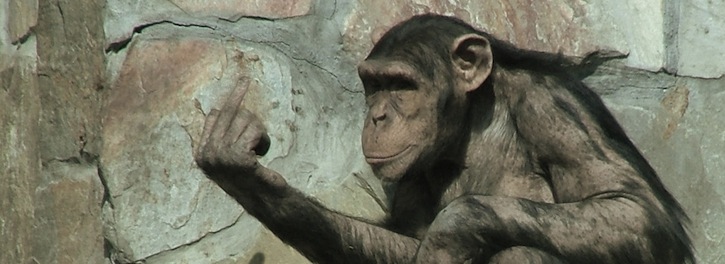
In a recent study, Stirling researcher Dr. Ana Roberts found that the chimpanzees used from 20-30 hand gestures as a means of communication. Roberts’ findings could reshape how we think about language evolution.
“Chimpanzees use the gestures intentionally to elicit a desired response from other chimpanzees,” said Roberts. “They may be the missing link between ape and human communication.”
To carry out the study, Roberts spent several months watching a group of wild chimpanzees in Uganda, noting the hand and body gestures that the chimps used to relay concepts to one another. Roberts noted that the wild chimps used flailing arms to send other chimps away, beckoning gestures to draw their partners closer, clapping motions to express excitement, begging to ask for food and a variety of very human-like hand and arm movements to indicate their desires and needs.
Other researchers have noted body language in wild chimpanzees for decades, but Roberts’ research is different in that it recognizes that many of the gestures are fundamentally similar to human body language. For Roberts, the similarities are too significant to ignore or to pass off as coincidence. She believes that chimpanzees and humans shared a common ancestor that also used some of the hand gestures as a form of early language.
[ad2]
“We now know that these gestures must have been in the repertoire of our common ancestor and might have been the starting point for language evolution,” said Roberts. “Manual gesture in chimpanzees is controlled by the same brain structures as speech in the human brain.”
Interestingly, the chimpanzees also used context to determine the actual intention of their communication partners. A chimp might interpret a certain gesture in several completely different ways depending on the state of the “speaker.” Likewise, chimps might make different types of gestures to influence the actions of the listener.
In a sense, chimps cooperate through their communication, using their language as tools to get food, water, sex, shelter and other essentials. This form of cooperation is critically important from an evolutionary standpoint, and from an evolutionary perspective, it indicates the origin of language and complex communication.
“The defining way that people understand communication with others is by figuring out what someone really means by ‘mind-reading’ their intentions and we have discovered that chimpanzees may have a similar ability,” Roberts said. “The ability to co-operate and learn from others paved the way for language evolution. “
Roberts said that because wild chimpanzees interpret language in a very human way, they possess the cognitive skills for what modern linguists define as language. This means that the chimpanzees communicate in a fundamentally human way and that the evolutionary history of language likely extends back to a common origin point much older than what was previously believed.
“If chimpanzees learn the precise structure of their gestures from others, this means that the fundamental cognitive skills required for language evolution are already present in our closest living relatives,” said Roberts.

Thanks for this terrific insight. Gotta admire someone who spends months observing chimps!